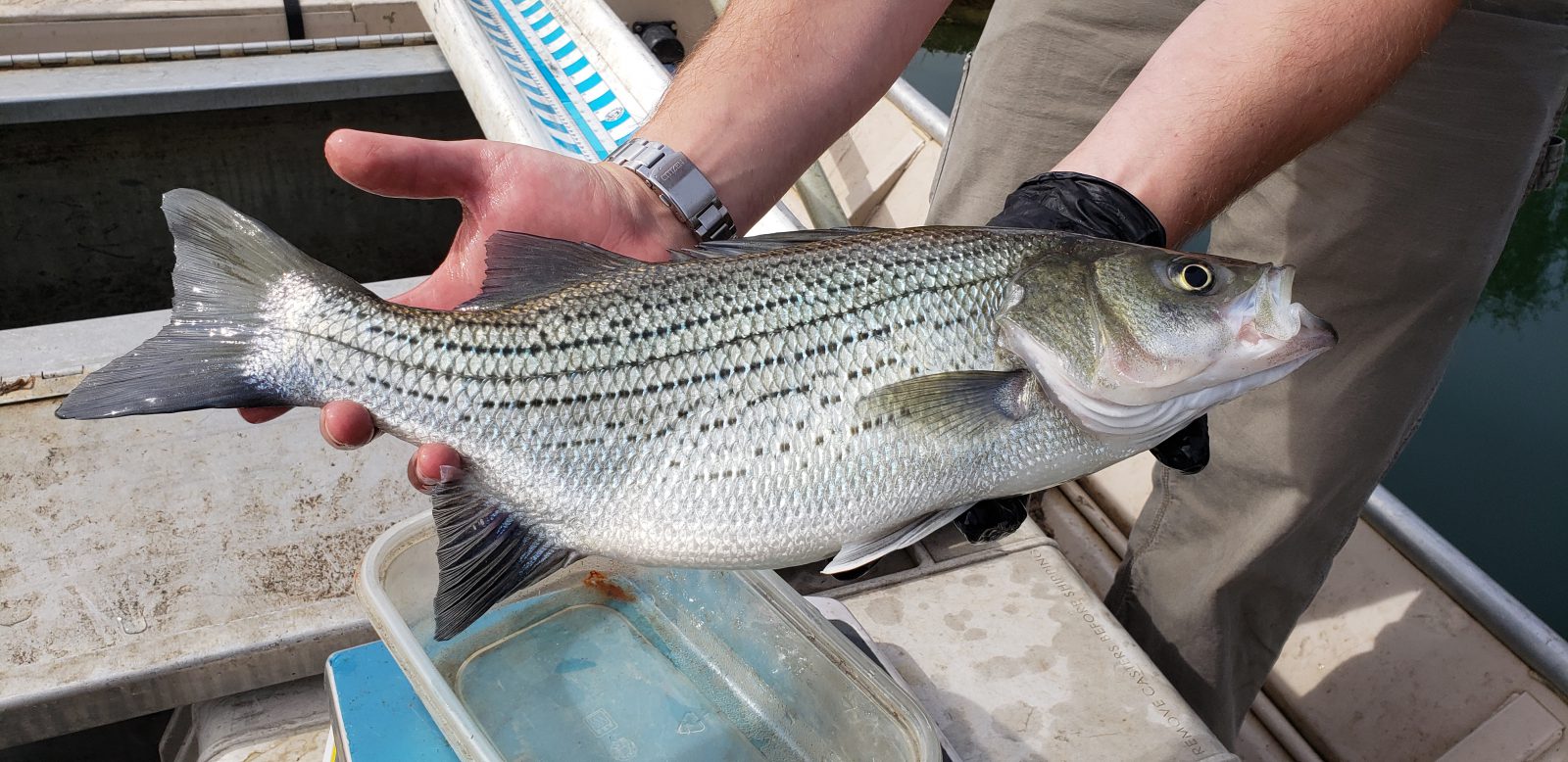
Creating a Trophy Fishery: From Tiger Muskie To Hybrid Striped Bass
Across this nation are some truly magnificent properties where man has utilized nature’s offerings and helped mold and create a truly spectacular setting. Located in a remote area of West Virginia, completely off the grid with the exception of a landline, is such a property. This place is stunning. Entering the driveway on my first visit, it was apparent this landowner has great vision. At that time, the property had four ponds bordering a par three private golf course that plays as a nine-hole course, even though it has three greens. There is a live, vibrant stream meandering through the property, adding ambiance and character to the outdoor feeling of serenity. The main house has a modern, yet rustic touch that ties to the mountain backdrop a few feet out the back door. Adding to the distant landscape is a large national forest bordering the property, providing countless benefits, both esthetic and ecological.
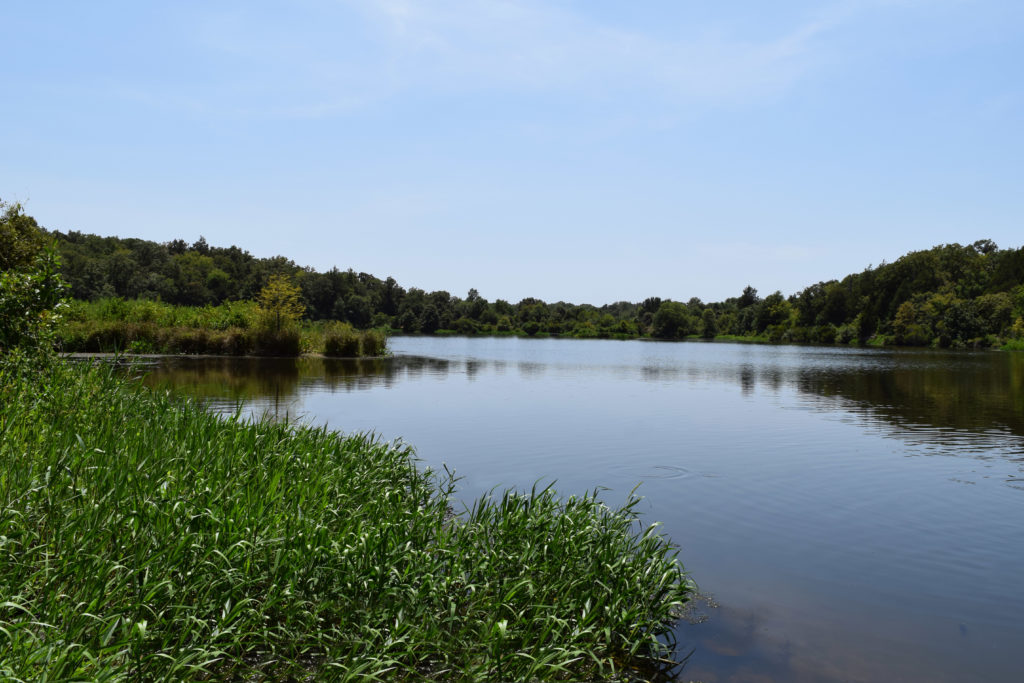
For our mission, we were particularly interested in the extensive watershed of clean, seasonal runoff that lends itself to the idea of creating a trophy fishery.
We were called to the site to help meet the owner’s goal of enhancing the four ponds. During the first site visit, we found the main waterbody, a 5.5-acre jewel-in-the-rough, was nearly 25 percent covered with white water lilies. The three additional ponds were located adjacent to the main pond.
Together these three ponds totaled 7 acres and did not have any invasive aquatic vegetation issues. The layout of the three smaller ponds was much different than the larger one. The larger pond was a hundred yards wide in two places, providing open water, while the smaller ponds had much more shoreline with a narrower design. Several areas of the smaller ponds were only twenty yards wide. In addition to having more shoreline, the smaller ponds were also shallower. Water temperatures in all the ponds remained cool throughout the summer with most of the water column staying in the mid to upper 70’s.
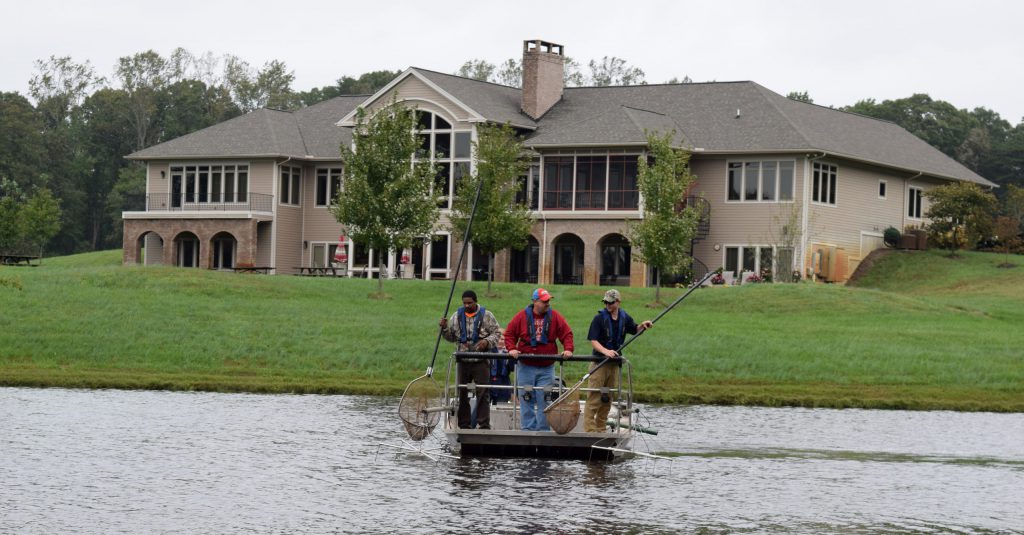
The first management task addressed was eradicating the white water lilies. They were disrupting the ability to fish the main pond, while also taking away from the esthetics of the property. To manage the lilies we used an approved granular herbicide selectively where plants are actively growing. A couple months later any stragglers went away with a foliar treatment using a liquid herbicide.
Once the lilies were gone we analyzed the existing fishery with electrofishing equipment so we could develop a fisheries management plan. With the owner and family on site, helping with the electrofishing survey, we determined the ponds were dominated by stunted largemouth bass, with an abundance of large black crappie and a healthy population of aging adult bluegill. The study also revealed edible size forage fish were practically nonexistent. The fishery was top-heavy with predator fish and a group of old bluegills.
A water quality analysis determined that the pond had an alkalinity level of 10 mg/l (milligrams per liter, same as parts per million). That’s a little bit low if we want to manage a plankton bloom.
When evaluating the number of adult bluegill, it was fairly tempting for the owner to think his forage base was sufficient to support this predator fish population. The reality was largemouth and crappies were far too abundant for his bass to grow. A baby fish of any species didn’t stand much chance at survival. So, considering the beautiful environment surrounding the ponds, it was clear that improving the fishing was a vital missing link to maximizing the property’s potential and achieving the owner’s goals.
With some tough decisions on the landowner’s part and a few months to consider and tweak the proposed vision of a great cool water/warm water fishery, the owner decided to go all-in. He chose the option to reset the ponds and create a trophy tiger musky, largemouth bass, and hybrid striped bass fishery. The plan was to start over from scratch and connect all four ponds into one larger water body that has both open water habitat and a riverine one. The open water would be utilized primarily by the hybrid striped bass, while the extensive shoreline and cover would cater to the tiger muskie and largemouth bass.
With a plan in place, it was time to get to work
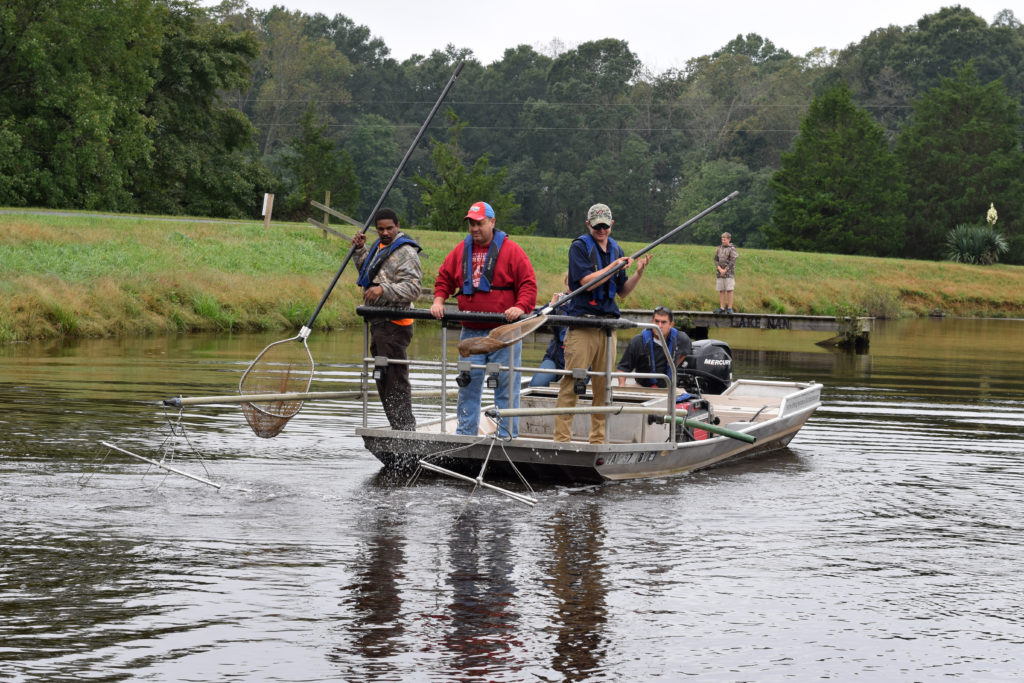
First, the ponds were drained to improve the habitat and eradicate existing fish. Once the ponds were lowered several feet, they were electrofished again to harvest as many fish as possible to ensure that good-eating fish did not go to waste. Following fish removal using the electrofishing boat, rotenone was applied at one gallon per acre-foot to ensure that we achieved a complete reset.
Meanwhile, the ponds were all being mucked out with heavy equipment and connected to form one lake. Two of the smaller ponds had been leaking for years and were lined with new clay to prevent future leaks. To do this, clay was mined from the backside of the largest pond, resulting in a two-acre expansion—more pond!
While all of this was going on, other tasks were being accomplished to improve fish habitat. Limestone sand was spread in areas throughout the ponds. This was done to boost low alkalinity levels upwards to 40 to 50 mg/l. In addition, limestone gravel, which is similar in size to pea gravel, was spread over areas throughout the ponds to improve spawning sites for bluegill reproduction.
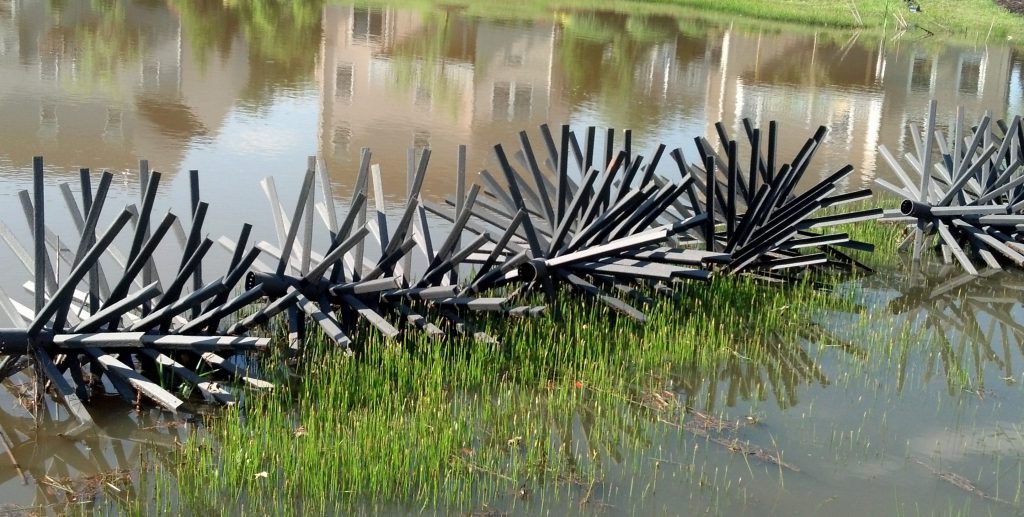
As for the fish cover and habitat improvements, a combination of large boulders and logs along with artificial cover were used. To provide habitat for both larger and smaller fish, large rocks and boulders were placed in areas and then teamed with dense artificial cover. Logs were placed parallel to the pond bottom but perched a couple of feet off the bottom to provide shady areas for predator fish to ambush prey. Dense artificial cover was installed in shallow water to serve as nursery areas and travel routes for small fish. Long underwater head rows were made of a five-foot tall cover and designed to create ideal fish habitat in open water for fishermen to target tiger muskies and largemouth.
After several months, with the fish cover in place and the earth moving completely, the lake’s main valve was closed to allow the lake to begin filling. Fish feeders were assembled and placed along the lake’s perimeter to feed forage fish and increase productivity.
Once the lake had several feet of water, it was time to stock the forage fish. Fathead minnows, golden shiners, and bluegill were stocked to establish a healthy forage base.
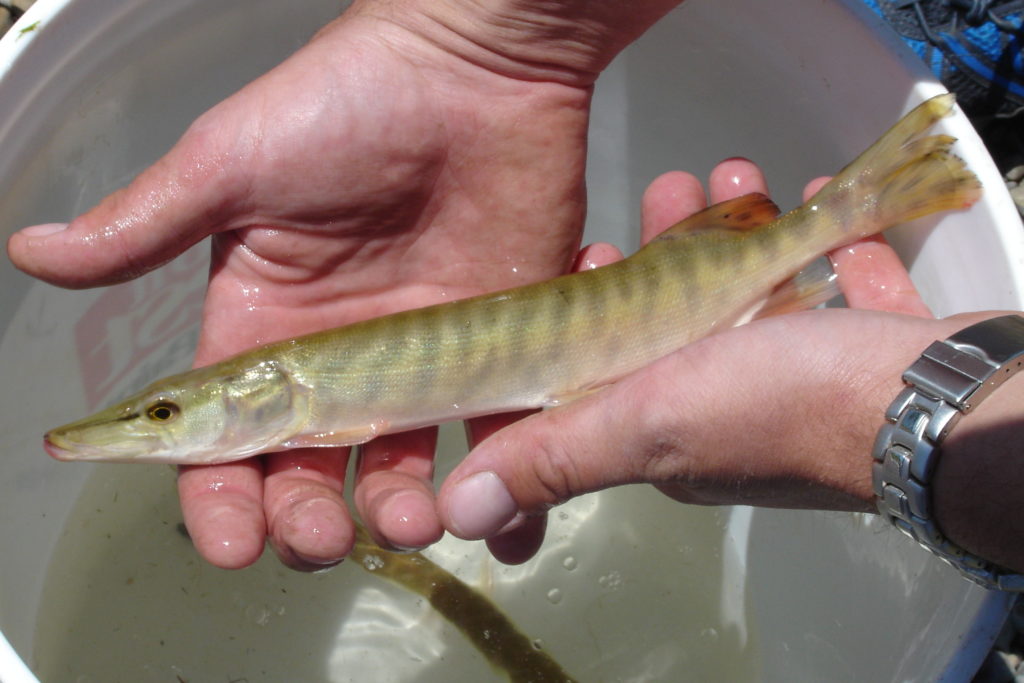
Based on the timing of the project and the desire to stock yearling tiger muskies and establish their population before any of the other predators, muskies were stocked in late fall, a few months following the forage fish. For the next 18 months bass will take a back seat to ensure establishment of a healthy forage base and a healthy population of young tiger muskies. Based on projected musky growth rates, the striped bass and largemouth will be stocked in the spring of 2015. Female largemouth will be stocked in attempt to establish a fishery that does not have a reproducing population of predator fish. Although the bass will be stocked later than desired by the resident bass fisherman, they should grow rapidly once stocked as the forage base should be thriving.
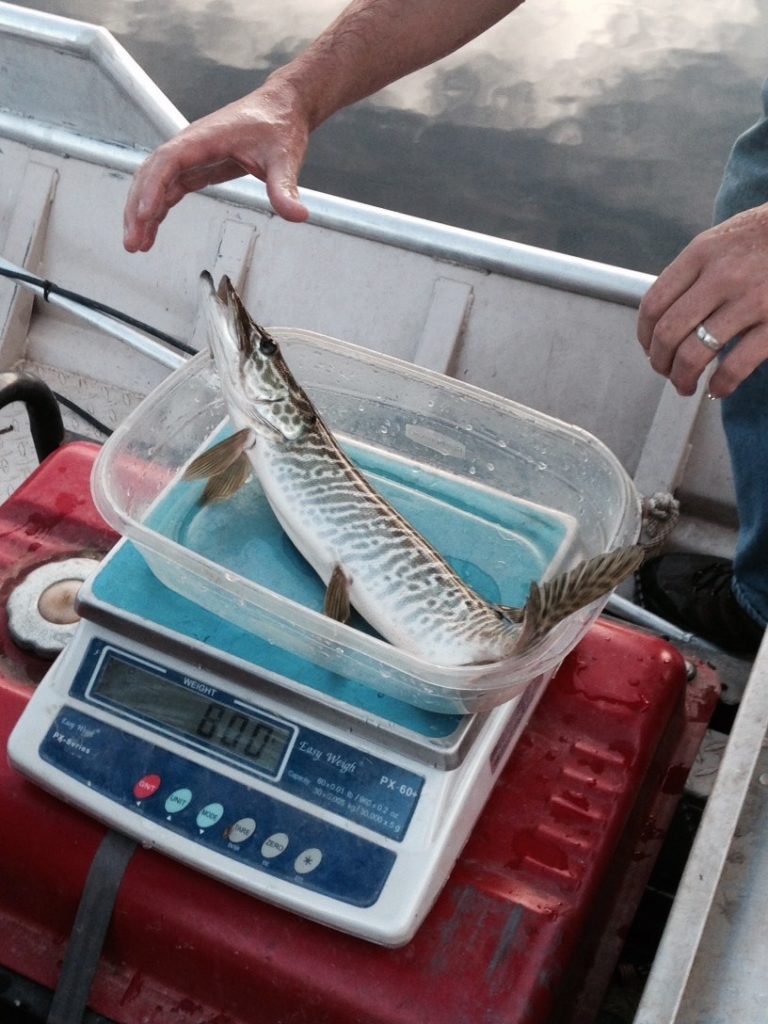
Trying to establish tiger muskies in ponds can prove to be challenging, at times. To improve our ability to track growth rates and estimate their population, all tiger muskies stocked were weighed, measured, and tagged using anchor tags. Prior to weighing and measuring, the fish were anesthetized to minimize stress and improve fish survival. Although tiger muskies can handle stress fairly well as long as water temperatures are cool, they are still difficult to tag, as they are skinny, slimy, torpedo-shaped fish.
This project has a large amount of work remaining and continued progress to come. In spring or early summer electrofishing will begin providing an understanding of how the muskies made it through the winter and spring as juveniles. In this first year, they are very vulnerable to predation and it will be important to assess and project population estimates after one year in the system. Additional tasks taking place throughout 2014 will be installing lake aeration systems, stocking more forage fish, establishing a population of yellow perch, testing water quality, feeding fish, fertilizing, building a boathouse, and building several bridges. As this project unfolds it will be fun to see how quickly the tiger muskies will grow and how this system without reproducing predator fish responds to management strategies over the years.
Managing Fish Habitats
SOLitude Lake Management is a nationwide environmental firm committed to providing sustainable solutions that improve water quality, enhance beauty and preserve natural resources.
SOLitude’s team of aquatic scientists specializes in the development and execution of customized lake, stormwater pond, wetland and fisheries management programs. Services include water quality testing and restoration, algae and aquatic weed control, installation and maintenance of fountains and aeration systems, shoreline erosion control, muck and sediment removal and invasive species management. SOLitude partners with homeowners associations, golf courses, private landowners, businesses and municipalities. SOLitude Lake Management is part of Rentokil, a leading business services company, operating across the United States, Canada and Puerto Rico.
For more information, visit SOLitude Lake Management at solitudelakemanagement.com, and connect on Facebook, LinkedIn and Twitter.









